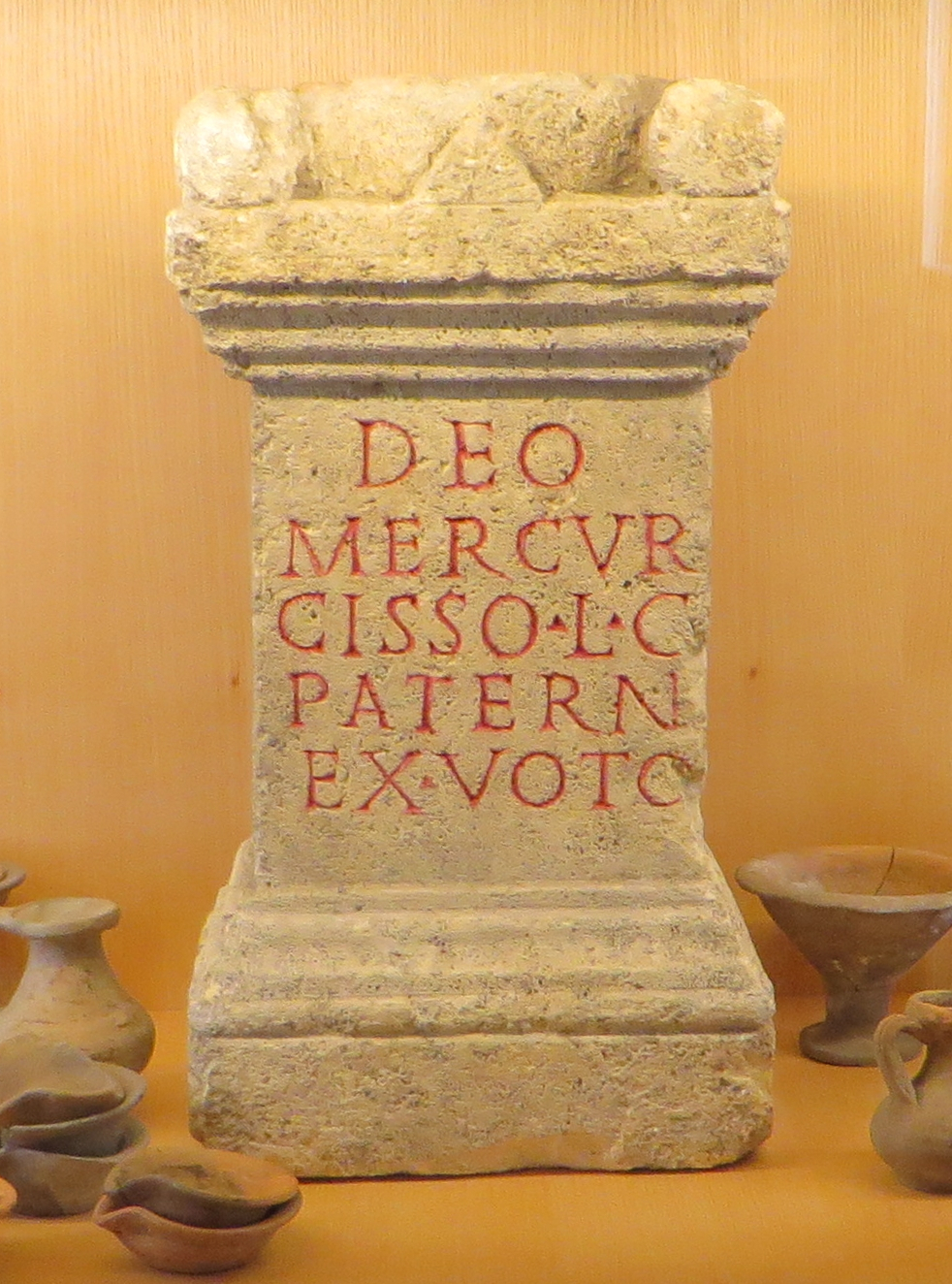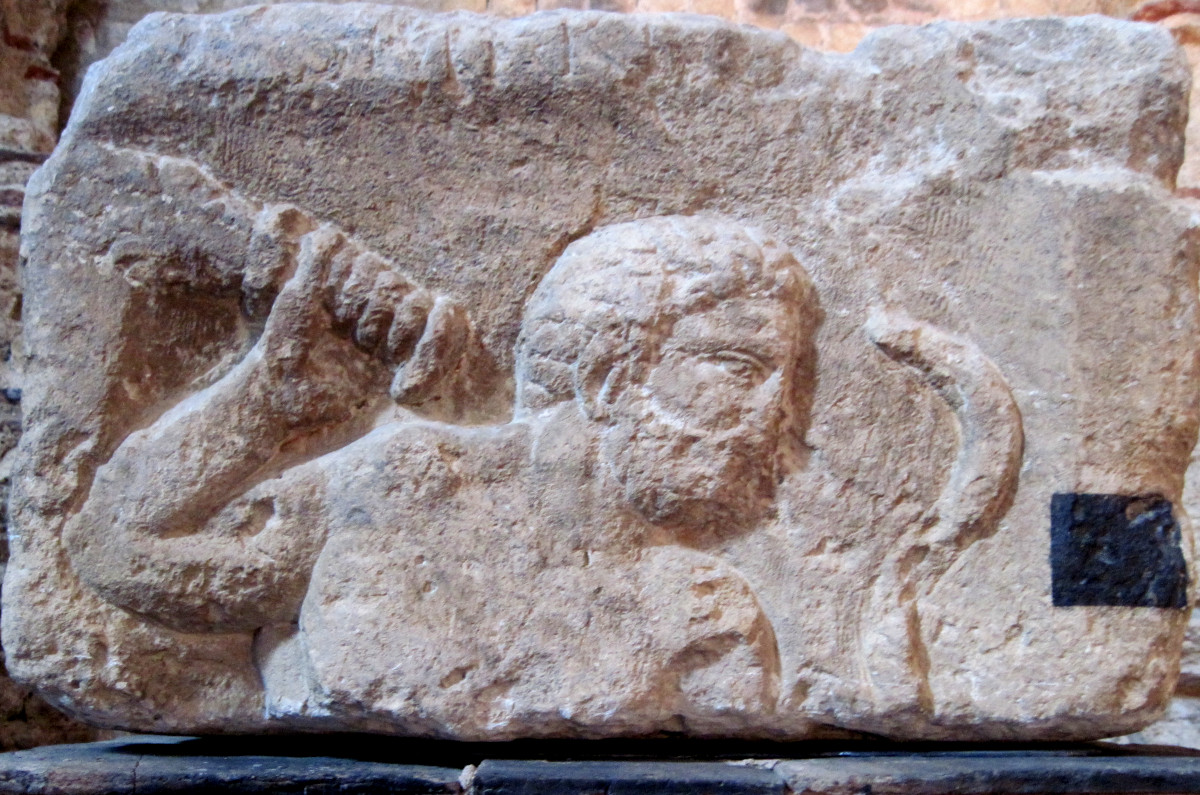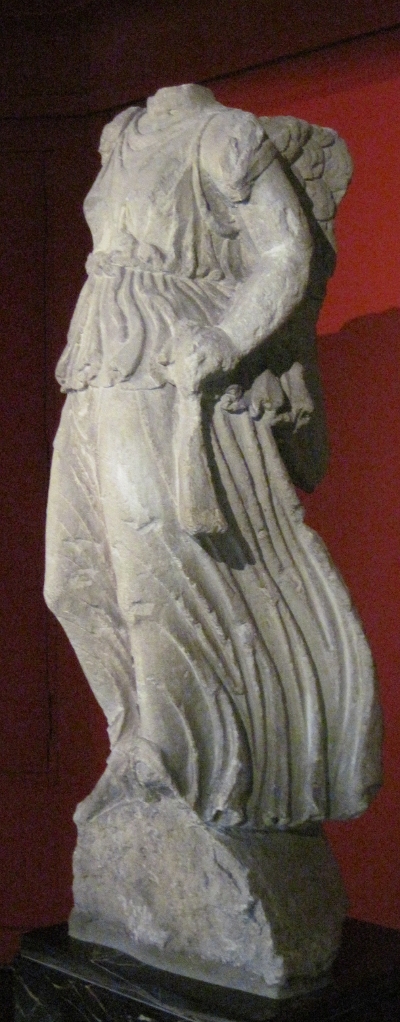Religious Syncretism in Roman Gaul:
Sketch of a Typology
Typology
(syncretism with mixed nomenclature (stable or
occasional epithet;
novel nature;
geographical,
functional, or
general epithet),
translation or interpretatio
(mixed couples,
indigenous iconography),
Classical iconography,
functional identification) ·
Meanings
Introduction
Gallo-Roman religion is characterized by its various modes of syncretism and cohabitation between Classical and indigenous elements. You need only visit a local archæology museum in France, Belgium, Switzerland, Luxembourg, or the Rhineland to come face to face with this reality, which is confirmed by the religious inscriptions of ancient Gaul. Although many theories have been developed on the mythology, symbolism, and cosmology of the pre-Roman Celts in Gaul, the bulk of the evidence comes in fact from Gallo-Roman monuments from which the so-called Roman elements have been stripped away or ignored, even at the risk of obscuring the context and intention of the original worshippers. Within Gallo-Roman religion, cultural mixing is neither an exotic choice nor a deviation, but rather a fundamental reality of a population that had accommodated itself to Classical civilization over the centuries.
This page aims to sketch out the varied forms of Gallo-Roman syncretism, for which I present a provisional typology, and to suggest some ways to make sense of the dialogue of civilizations and theologies that it demonstrates. Before tackling that complicated subject, I’d like to briefly lay out the historical context for that dialogue.
The Roman conquest of Gaul was completed in 52 BCE. This was an enormous human tragedy, the victims of which could be counted in the hundreds of thousands of people killed, mutilated, displaced, or sold as slaves. But this was not the end of Gaulish history. Faced with the new condition of things, Gaul stabilized. The population of conquered Gaul was restored, not through an influx of Roman settlers, but through natural increase among Gaulish peoples; in the provinces conquered by Julius Cæsar, only three settler colonies were established: Lugdunum (Lyon), Noviodunum (Nyon), and Augusta Raurica (Augst near Basel). Central authorities under Augustus and Agrippa provided a road network and models for urban planning, but it was ordinarily local Gaulish élites who took charge not only of rebuilding Gaul but also endowing new forums, temples, theatres, and so on. Moreover, the dialogue between Gaulish and Græco-Roman civilizations was already centuries old. The new leaders of the Gaulish tribes, which had become Gallo-Roman city-states, were often Gaulish aristocrats who had fought for the Roman army. Those who had the means sent their sons to study Latin rhetoric and Greek philosophy in Marseille or Autun. Roman trade spread out into the interior.Albert Grenier (1946), La Gaule : province romaine, p. 29., Greg Woolf (1998), Becoming Roman, Cambridge, pp. 114, 116, 125.
Thus, a Gallo-Roman civilization was built upon the ashes of the Gallic Wars. It stood alongside the mixed civilization already in place in southern Gaul, where Celtic, Greek, Iberian, Ligurian, and Roman populations had long rubbed shoulders. Élites in the Three Gauls never completely repudiated their Celtic (or Germanic or proto-Basque) heritage, even as they put their new Classical affinities to work. Even Julius Sabinus—the figurehead of a rebellion against Roman power in 69 CE—boasted of his descent from a bastard of Julius Cæsar.P. Cornelius Tacitvs (c. 108), Historiae IV.55. Meanwhile, ordinary people also participated in this cultural integration. Many of the people who made dedications to so-called Roman deities were themselves peregrines (that is, non-Roman citizens), while Roman products such as wines, olive oil, and fish sauce found a new mass market in Gaul.Greg Woolf (1998), Becoming Roman, Cambridge, p. 174.
I don’t want to minimize the violence, inequalities, or exclusion inherent in Roman society. This was a slave society. Social stratification was severe—at the top of the pyramid was the Emperor with his entourage, then a scattering of ultra-wealthy Senators, then Roman knights, commoners with Roman citizenship, peregrines without it, freed people, and finally slaves. A hierarchy among slaves mirrored that among free people, depending on the status of the masters or the privileges accorded to the slaves. The army—made up of Roman citizens and well-born peregrines—played an outsized role in affairs of state. All this being said, the Gauls found ways to adapt to this fait accompli, and even to prosper during the Pax romana. Even when it became possible in 69 CE to embark on a new constitutional order, a ‘Gaulish Empire’ independent of Rome, Gaulish leaders found themselves embroiled in too many perplexities to commit to it. Many applauded the rebels’ patriotic sentiments yet preferred to remain in the Roman ambit. Such at least is the anecdote we have from Tacitus—himself a Senator probably from Gaul and by no means favourably inclined to Roman imperial power.P. Cornelius Tacitvs (c. 108), Historiae IV.69.
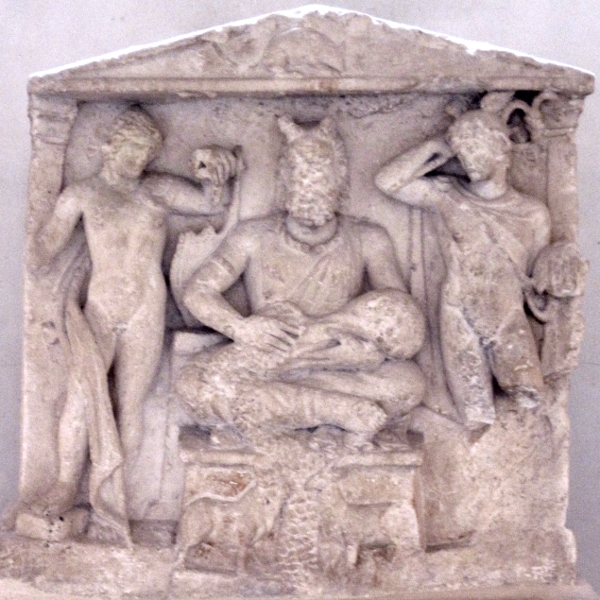
The Reims altar, depicting Cernunnos alongside Apollo (left) and Mercury (right).
(Musée Saint-Remi, Reims)
Celtic deities continued to be worshipped in Gaul under the Roman ægis for five centuries. Most of the quintessentially ‘Celtic’ statues and inscriptions date from this Gallo-Roman period, not that prior to the Roman conquest. Examples include the Pilier des Nautes parisiaques (which depicts Cernunnos, Esus, Tarvos Trigaranus, etc.), the altar of Sucellus and Nantosuelta at Metz, and the altar of Reims on which Cernunnos, Mercury, and Apollo are depicted side by side.
Syncretism as Observed
Next we’ll turn to syncretism as revealed by iconographic and epigraphic evidence. This takes a number of forms. First, there are deities with mixed names (Latin and indigenous (normally Celtic))—a phenomenon whose nuances are already quite varied. Then there are deities whose Gaulish names accompany a Classical iconography, or vice versa. Just outside the definition of syncretism sensu stricto are mixed couples of deities (these are normally a Roman god with a local goddess). And finally there are local deities whose functions seem to suggest a particular identification even when epigraphy does not definitively establish it. The complexities are many, and we shall by no means exhaust the subject.
Interpretatio refers to the well-known phenomenon by which deities thought to originate in different pantheons are identified with one another. Depending on the language of those interpreting, one might speak of interpretatio romana and interpretatio graeca, but modern scholarship also emphasizes the agency of local peoples in these choices. Imperial power did not dictate theology to the Gaulish city-states, which on the contrary were largely free to define local deities as they saw fit. This is more precisely interpretatio indigena.Ralph Häusseler (2012), “Interpretatio indigena: re-inventing local cults in a global world”, Mediterraneo antico XV (1–2): pp. 143–174.
Deities with Mixed Names
The clearest and commonest type of syncretism is the juxtaposition of a Latin and a Gaulish theonym. Examples of this include Mars Mullo or the god Mercury Moccus. In neither case does epigraphy reveal any attestation of the Celtic name (Mullo or Moccus) without a Latin theonym.In the case of Mullo, one inscription (AÉ, 2007: 939) out of a dozen provides a different identification: Deo Inuicto Mulloni, or ‘to the Unvanquished God Mullo’. The ‘Unvanquished God’ is normally the Unvanquished Sun (Sol Inuictus), but sometimes Mithras or even Hercules. Thus, it is strictly speaking incorrect to speak of a cultus to Moccus alone; the only explicit attestation there is (at Langres) concerns Mercury Moccus.CIL, XIII: 5676. The votive stone in that case is also dedicated in honorem domus diuinae ‘in honour of the divine house’, i.e. to the imperial family.
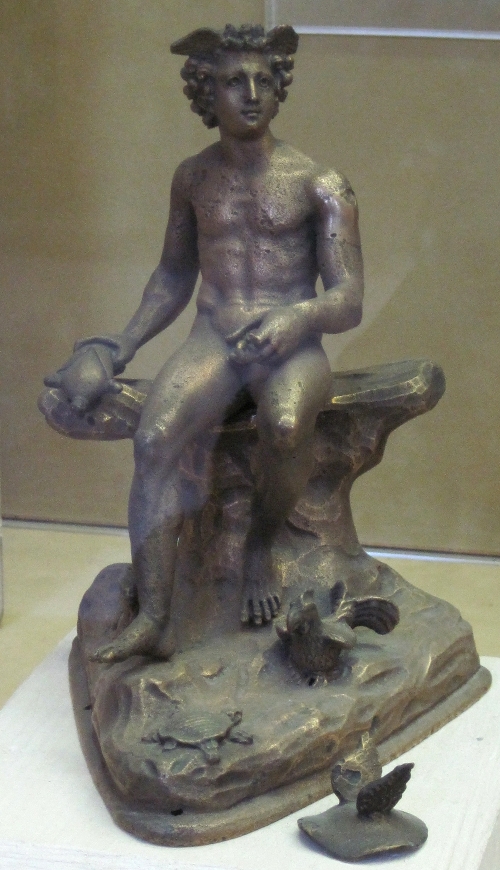
Bronze statuette of Mercury found at Reims. This may depict the monumental statue of Mercury from the Puy de Dôme (commissioned from Zenodorus at a cost of 𐆘400,000)
(Musée Saint-Remi, Reims)
Identifications were not made at random. The great majority concern a relatively small number of Roman deities: above all Mars, quite often Mercury and Apollo, sometimes Silvanus, Hercules, Diana, and Victoria, rarely Jupiter or Minerva—and almost never Venus, Juno, Vulcan, or Fortuna, even though their cultuses were quite well established in Roman Gaul. Each Gaulish people seemed to have its own favourite avatar of Mars (or even more than one) to the extent that epigraphic evidence is abundant enough to identify it. Thus in the case of the Helvetii, this was Mars Caturix, while Mars Cnabetius was favoured by the Mediomatrici, Mars Leherennus by the Convenæ, Mars Mullo by the Riedones, Mars Loucetius by the Vangiones, and Lenus Mars by the Treveri. We even seem to have a name for this phenomenon, namely Toutatis, the warrior-god of the tribe.Pierre-Marie Duval (1993), Les dieux de la Gaule, Éditions Payot. The Toutates of the various city-states thus shared one basic function, along with a common iconographic idiom (i.e., the god is depicted as a warrior with a Corinthian helmet, shield, and spear). These ‘Martes’ are thus analogous but distinct; their respective names indicate various qualities, and cultic practices may also vary (for example, Lenus Mars has a healing aspect that is not found everywhere).
Mercury, on the other hand, though endowed with numerous Celtic and Germanic identifications, is most often referred to simply as “the god Mercury” (or deo Mercurio in the dative). Celtic names for him frequently associate him with a place-name, though perhaps without defining the god’s identity exclusively. I’ll return to this theme below.
Epithets of Apollo are fairly diversified geographically, but in any given region a single epithet predominates. The functions of Apollo Belinus (in the South), Apollo Borvo (in the Massif Central), Apollo Grannus (in the East), and Apollo Moritasgus (near Alesia) seem to have been fairly similar. In each case, we have a healing Apollo endowed with healing hot springs and most often depicted playing the lyre. These hypostases of Apollo are not identical but, if you like, complementary. This situation more closely resembles that of Mars than Mercury—but as with Mercury, dedications to “the god Apollo” without any epithet are common.
The identifications of local gods with Mars, Mercury, or Apollo might be older than the Roman conquest.Jean-Louis Brunaux (2006), Les druides : des philosophes chez les barbares, Éditions du Seuil, pp. 231–234, 238–239. They occur in a cultural context in which different peoples commonly recognize in the deities of others the same deities that they worship themselves. As Plutarch remarks,
“not different gods amongst different people, nor Barbarian or Grecian, of the South or of the North—but like as the Sun, Moon, Sky, Earth, Sea, are the common property of all men, but yet are called by different names by different nations; in the same manner, as one reason regulates all things, and one Providence directs, and subordinate Powers are appointed over all things, yet different honours and titles are by custom assigned to them amongst different peoples”.Plvtarchvs (c. 100), Moralia, “De Iside et Osiride” lxvii. Translation by Charles William King (1908) on sacred-texts.com.Such at least is the opinion of a Greek philosopher who was both a Roman citizen and an enthusiast for Egyptian religion…! Cultural contact very frequently resulted in religious interpretationes. Romans did not hesitate to “interpret” the Greek Hera, for example, as their goddess Juno, despite the important nuances that distinguished their Greek and Roman characterizations. Interpretation does not set nuance at naught, but rather it establishes a context for it—a basis for comparison. I shall return to this question below.
My readers will doubtless have observed that the Latin name typically precedes the Gaulish one, as is the cast with Mars Camulus, Diana Abnoba, Mercurius Cissonius, Apollo Grannus, and so forth. But the order is reversed in a small handful of cases: Lenus Mars, Sulis Minerva in Britain, at times Loucetius Mars, Visucius Mercurius in one unusual case, and perhaps a handful of others.
There are still further variations on the theme, which I will profile in the subsections below.
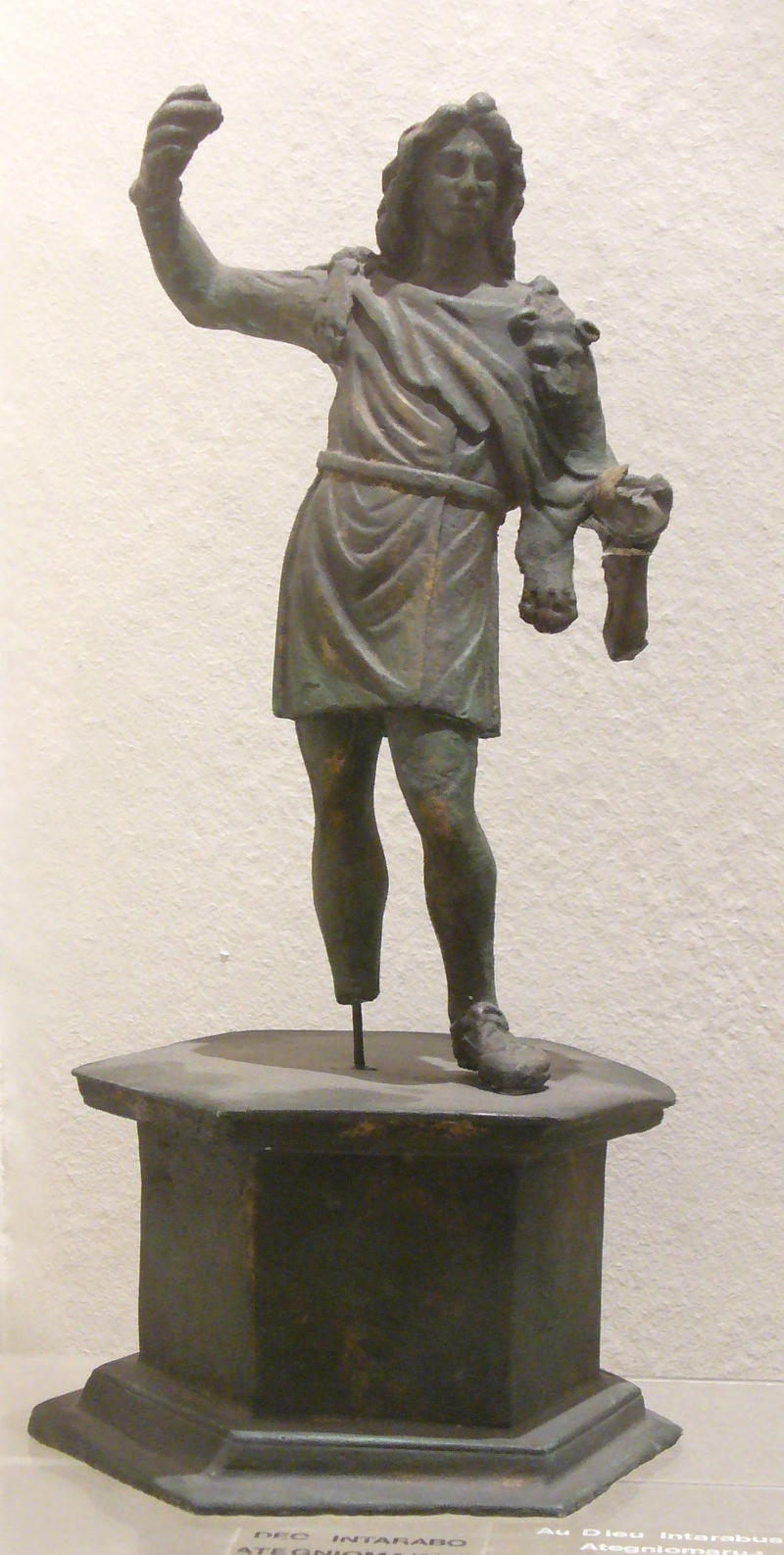
Statuette of Mars Intarabus with a wolfskin, discovered at Bastogne-Noville
(Musée archéologique luxembourgeoise, Arlon)
Deities with an Occasional Identification
Not all identifications are alike. Sometimes, the identification is stable and regular. Rarely does one mention Camulus without identifying him as Mars Camulus. On the other hand, Intarabus is normally invoked as “the god Intarabus”; only a single inscription identifies him with Mars,CIL, XIII: 3653. and it is found on a bronze statuette that depicts him somewhat as Silvanus…. This apparent allusion to Mars Silvanus strikes me as occasional or even improvised, in contrast to the ubiquity and stability of the Mars–Camulus identification.
Another kind of probable theological improvisation is to be seen in the identification at Trier of two deities as Vertumnus siue Pisintus ‘Vertumnus or else Pisintus’.AÉ, 1928: 190. The formula “X siue Y” is relatively rare in Gaul; in itself it signals the provisional nature of the identification.
Many epithets are one-offs. Sometimes the deities thus identified are already known; for example, Mercury the companion of Rosmerta is called “Excingiorigiatis” on one inscription at Ueß;AÉ, 1935: 29. an inscription at Branges among the Ædui calls upon Apollo Grannus AmarcolitanusCIL, XIII: 2600. ‘wide-seeing’.Xavier Delamarre (2003), Dictionnaire de la langue gauloise, Éditions Errance, p. 40. Such one-offs may provide additional nuances to our understanding of the deities in question provided that their etymologies are clear enough. In the case of Apollo Grannus, the hypothesis that he is a solar deity fits nicely with an epithet that underscores his universal vision, a classic characteristic of ancient sun-gods. A cultus of Amarcolitanus cannot be separated from that of Grannus: the only attestation of the word Amarcolitanus is as an epithet of Apollo Grannus.
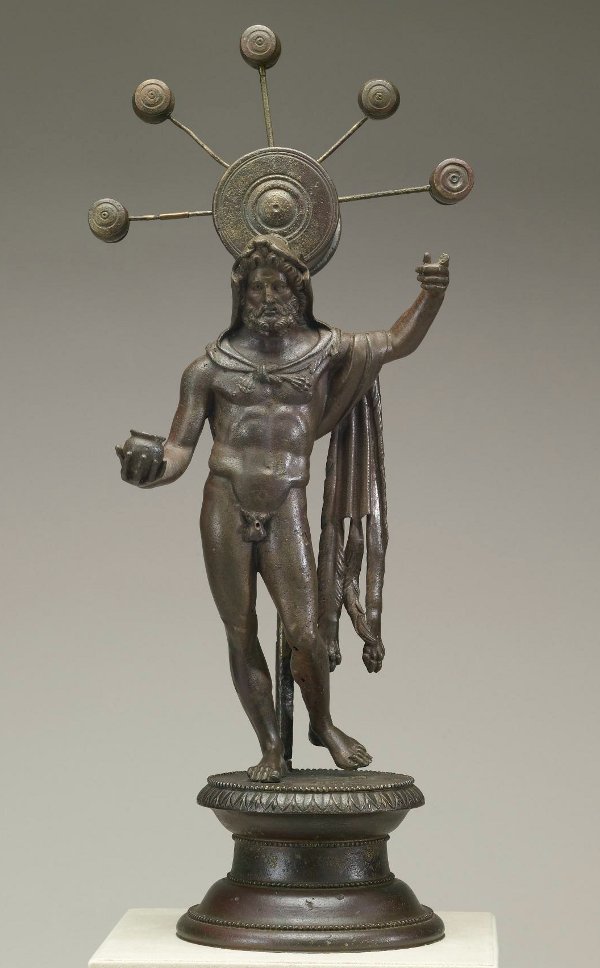
Statuette of Sucellus from Vienne. The god is nude except for a wolfskin; he carries an olla in one hand and doubtless a mallet (now vanished) in the other. Behind him, one enormous mallet terminates in a crown of five smaller ones.
(Modification of a photo from the Walters Art Museum, Creative Commons BY-SA)
Hybrid Deities
At times, identifications reveal a real theological evolution. This is notably the case, in my opinion, with the Gaulish Silvanus, who exemplifies the coexistence of two deities (Roman Silvanus and Gaulish Sucellus) who contribute to the syncretism of a deity of hybrid character, namely a ‘Sucelus Silvanus’ with mixed iconography (although with that said, this hybrid deity is most often called ‘Silvanus’ alone). For this reason, polytheists often declare that one plus one makes three.This polytheist bon mot is attributed to Tamara Siuda, founder of the Kemetic Orthodox tradition. P. Sufenas Virius Lupus (2016), Antinoan Mysteries, p. 16. Syncretism results in the coexistence of two original deities alongside a third, participating in the nature of both.
Deities with Geographic Epithets
Deities are often given epithets referring to an important cultic location. In light of the prestige of the sanctuary of Mercury at the summit of the Puy de Dôme (a prominent volcano in the territory of the Arverni), it is not surprising to find epithets like Mercurius Dumias ‘from the Puy de Dôme’ or ‘of the hill’Delamarre (2003), op. cit., pp. 153–154. or Mercurius Aruernus ‘the Arvernian’. Other cases involving Mercury include Mercurius Vosegus ‘of the Vosges’, Mercurius Bigentius ‘of Piesport’, Mercurius Cimbrianus ‘of the Cimbri’, and Mercurius Canetonessis ‘from Berthouville’Monique Dondin-Payre, « Celtiques ? Romains ? Indigènes ? Importés ? Divinités et pratiques religieuses dans l’empire romain de l’Occident. » Page 82 in Marie-Odile Charles-Laforge (2014), Les religions dans le monde romain: Cultes locaux et dieux romains en Gaule de la fin de la République au IIIe siècle après J.-C. : persistance ou interpretatio ? Artois Presses Université..
What do such declarations of geographic belonging mean? They certainly underscore the particularities of local cultus, for polytheistic religions were and are decentralized, and the quirks of local cultus may be quite striking. It would be incorrect to go to the sanctuary at the Puy de Dôme in order to worship Mercury of the Vosges. Yet a local cultus will often spread beyond its place of origin. For example, most inscriptions to Mercury the Arvernian and Mercury of the Puy de Dôme are found far from the territory of the Arverni.
But must we consider Mercury of the Puy de Dôme a different god from the Mercury worshipped in neighbouring areas? Not necessarily, for this may indicate a specialized avatar of the same god—or even a specialized cultic discipline for worshipping the same god. Nevertheless, there are instances where the geographic epithet signals a truly distinct deity, such as Diana of Ephesus or Jupiter of Doliche (both of whom are known to have been worshipped in Gaul), whose origins, iconography, and cultic practices are quite different from those of their Classical counterparts. And yet … Diana of Ephesus is also a Diana; Jupiter of Doliche is also a Jupiter—if not, a different name would have been used to refer to them. It is paradoxical but true that names of the type “god X of place Y” at once insist on the identity of the deity as X and on the differentiation between the X found in place Y from other forms of X that may be encountered elsewhere. Though it’s an imperfect analogy, one might compare the Catholic cultus of Our Lady of Lourdes, who is characterized by a particular history (19th-century apparitions), a controversial theology (the Immaculate Conception), and noteworthy practices (supplications for miraculous healing). All of these characteristics set the cultus of Our Lady of Lourdes apart from those of the Black Madonna of Częstochowa or the Virgin of Rocamadour. But all three involve (hypostases of) Mary the mother of Jesus.
Deities with Functional Epithets
Other epithets refer not to places but to divine activities. One Celtic example, as we have seen, is Apollo Grannus Amarcolitanus ‘wide-seeing’; another, according to Patrizia de Bernardo Stempel, might be Mars Albiorix ‘ruling over the world’,Patrizia de Bernardo Stempel (2006), ‘Theonymic Gender and Number Variation as a Characteristic of Old Celtic Religion’. Pages 31–47 in M. V. García Quintela, F. J. González García & F. Criado Boado (eds.), Anthropology of the Indo-European World and Material Culture, 5th Colloquium of Anthropology of the Indo-European World and Comparative Mythology Santiago de Compostela 2004, Budapest 2006. known from an altar in the area of Vaison-la-Romaine. Similarly in Latin, Jupiter may be designated as conseruator ‘conserver’ or depulsor ‘deliverer from evil’; Mercury on one occasion is termed peregrinorum ‘of foreigners’.EDCS-25601387. De Bernardo Stempel classifies epithets like “Toutatis ‘of the tribe/town’” and “Cissonios [sic] ‘of the market [baskets]’” as belonging to the same category (“epikleseis of appurtenance”) as those referring to place-names or ethnic groups,De Bernardo Stempel (2006), op. cit. but to my mind it would be better to consider them as functional.
Functional epithets are normally limited to one deity in particular, for whom they define a key domain. There are exceptions, however. The epithet Iouantucarus ‘who cares for the young’ or ‘who loves youth’Delamarre (2003), op. cit., pp. 190–191. is attributed to both MarsCf. AÉ, 1924: 17. and MercuryCf. CIL, XIII: 4256. and is even used on its own.CIL, XIII: 10024, 6.
Deities with Generic Epithets
Other epithets are more broadly applicable. These are what de Bernardo Stempel calls “polyvalent epikleseis”, for example mogetios ‘mighty’.De Bernardo Stempel (2006), op. cit. In Gaul, most such epithets are Latin: augustus/augusta ‘venerable’, sanctus/sancta ‘holy’, uictor/uictrix ‘victorious’. The epithets inuictus ‘unvanquished’See the note above regarding Deo Inuicto Mulloni. and regina ‘queen’ are applied to several deities.In Gaul, regina normally refers to Juno, but in some cases to Isis, the goddess Candida, Minerva, or Fortuna. We also find instances of “Epona Regina” in the Danubian provinces. Another instance of a generic epithet, according to Ralph Häussler, is Smertrios ‘provider’,Ralph Häussler (no date), Ogmios | Smertrios / Smertullus | Hercules. Häussler also mentions the variant Smertullus, which is less well supported. which is applied to Mars,CIL, XIII: 11975 & AÉ, 1961: 328b. Dis,AÉ, 1950: 98. and Jupiter,AÉ, 1987: 756. as well as to the Herculean figure (with no interpretatio) on the Pilier des nautes parisiaques. Whether such an epithet be Gaulish or Latin, it is normally not ‘the name’ of the deity it is applied to. Kennings, titles, and by-names are widespread among deities cross-culturally, and it is only to be expected that such are to be found among Gaulish deities.
Although such epithets might theoretically apply to any number of deities, they are not in fact employed willy-nilly. Not every deity is designated as sanctus ‘holy’; optimus maximus ‘best and greatest’ is the sole property of Jupiter; inuictus normally evokes the Syrian Sun-god. The epithet augustus/augusta is used a bit more generally, even while hinting at the imperial cultus. It is most widespread among deities at Lyon, the seat of civil power in the Three Gauls.
In widespread use for both Latin and Celtic theonyms are words that de Bernardo Stempel classifies as “categories”; she cites as examples “deus/dea, genius, lares, matres, matronae, nymphae”.De Bernardo Stempel (2006), op. cit. The use of such categories is much more frequent in Gaul than in other provinces of the Roman Empire; thus, we have inscriptions that honour deus Apollo, the Matronae Aufaniae, dea Minerua, deus Sucellus, and so on.
Gaulish Deities with Latin Names
In some cases, a local deity seems to be invoked even under a Latin name. This can never be more than a plausible inference, but the evidence at times is striking. First, worship of a Gaulish deity is attested; then one finds a Latin name used in apparently the same cultus. This is the case for example with a goddess closely linked to Lenus Mars among the Treveri. Some inscriptions identify her as Ancamna,Cf. AÉ, 1915: 70. while on others, Victoria takes on this role.Cf. AÉ, 1932: 40. Are these really two distinct goddesses who were worshipped in the same places as cultic companions of the same god? Perhaps, but it seems more probable to me that some worshippers Latinized the name of a somewhat obscure local deity whilst ordering a votive inscription to be erected, knowing that that inscription would be seen by a cosmopolitan audience. I’d make a similar suggestion concerning the goddess Nemetona, worshipped alongside Mars Loucetius notably in the area of Koblenz and Mainz (a cultus closely parallel to those of Lenus Mars and Ancamna further up the Moselle). Nemetona too seems to transform into Victoria at times—but in Nemetona’s case, this is not a hypothesis but a fact, given that one inscription explicitly mentions Nemetona Victoria.AÉ, 2007: 1044.
This phenomenon—interpretatio properly speaking—is closely related to syncretism, and in particular to the phenomenon of hybrid deities, which I outlined above. In fact, the case of Sucellus Silvanus is full of examples of outright interpretatio where the hybrid god is simply called Silvanus (mallet, olla, and all). But in the case of Ancamna or Victoria, the name of an ‘allegorical’ goddess is given to a Celtic goddess whose nature is compatible. We may have similar instances with Fortuna, Felicitas, and Abundantia (all likened to Rosmerta?). In somewhat the same fashion, a Christian missionary might calque the name of God the Father as the ‘Great Spirit’ or the ‘Creator’ in the language of his listeners.
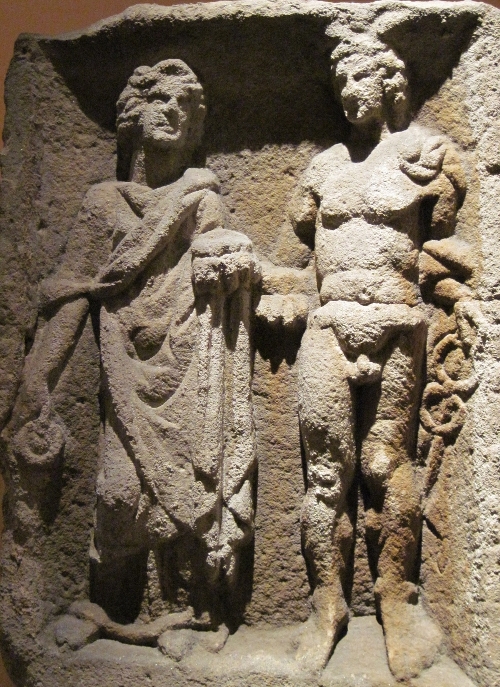
Depiction of Mercury and Rosmerta on an altar from Eisenberg. Mercury bears a caduceus and winged petasos, Rosmerta a money-bag and a patera.
(Historisches Museum der Pfalz, Spire)
Mixed Couples: Roman Gods and Local Goddesses
Neither ‘syncretism’ nor ‘interpretatio’ quite covers a parallel phenomenon, namely the joint cultus of a pair of deities. These are normally a god with a Latin name and a goddess with a Celtic one; such is the case for the famous couple Mercury and Rosmerta. Among other examples, one might cite Apollo and Sirona, Mars and Ancamna, and so forth. This phenomenon has been called a “divine marriage”; such is the term used by Miranda Green, who links this phenomenon with the theme of the sovereignty goddess in insular Celtic mythology.Miranda Green (1989), Symbol & Image in Celtic Religious Art. Routledge. The divine marriage is sometimes portrayed as a mythologized juxtaposition of Roman master brought into a local cultus alongside a Gaulish goddess who submits herself to him as conquered Gaul must submit to Rome. But the process might instead have gone in reverse: an originally Celtic couple indicates its openness to the wider Roman world by the Latin name given to the god as well as its fidelity to local tradition by preserving the Celtic name of the goddess. This would not, then, be a Roman god who had been brought in, but a Celtic god who had assumed a Roman identity.
Furthermore, we can hardly be sure about any marriage between deities—it’s an attractive hypothesis, but our depictions rarely suggest conjugal relations. We might instead speak of cohabitation or of cultic companions.
De Bernardo Stempel distinguishes another category, less frequently noticed, namely “‘homonymic’ theonymic couples”, such as Glanis and the Glanicæ at Saint-Rémy de Provence.De Bernardo Stempel (2006), op. cit. Likewise, we sometimes find a goddess Visucia mentioned along with Mercury Visucius.
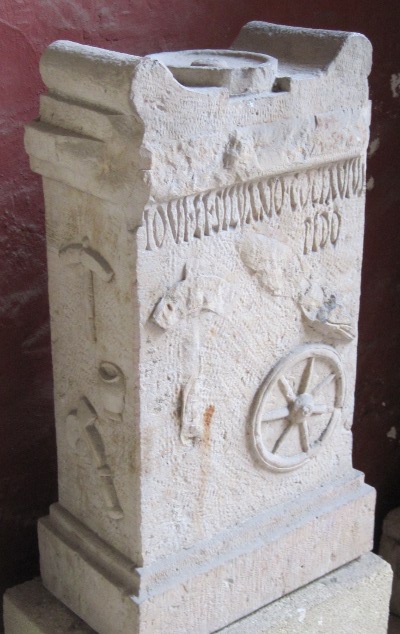
An altar from Nîmes, co-dedicated to Jupiter and Silvanus. Apart from the inscription, the altar is engraved with attributes of both gods: the thunderbolt and wheel of the Gaulish Jupiter, and the mallet, olla, and pickaxe of Silvanus.
(Musée archéologique de Nîmes)
Deities with Latin Names and Gaulish Iconography
A phenomenon often observed but too rarely acknowledged is a deity identified only by a Latin name but endowed with Celtic attributes. This is a kind of iconographic interpretatio. Depictions are frequently to be seen of Jupiter with a wheel, Silvanus with a mallet, Mercury with three faces—but modern commentators tend instead to gloss them with a Celtic name like Taranus, Sucellus, or Lugus. The use of Latin on inscriptions is not without significance. It was the language of prestige, the language of permanence, the language of the Empire. Therefore, it should not surprise us that Latin was often chosen for the deities of Gaul; the combination of Gaulish attributes and Latin name would have sufficed to identify the god in question for the local population. As Émile Thévenot puts it with regard to Rosmerta and Maia, whose iconography is practically identical,
“these purely verbal distinctions are without real-world significance. A Gaul who signs ‘Mercury and Maia’ might very well evoke in his thought, more or less consciously, a native god and Rosmerta. The important thing is that the cultus, even using Roman names as fashion dictated, did not change much in spirit.”Émile Thévenot (1968), Divinités et sanctuaires de la Gaule, Fayard, pp. 80–83. In the original: ces distinctions, purement verbales, sont sans portée réelle. Un Gaulois qui signe « Mercure et Maia » peut très bien évoquer dans sa pensée, de façon plus ou moins consciente, un dieu indigène et Rosmerta. L’important, c’est le fait que le culte, même sous des appellations romaines accréditées par la mode, n’a pas sensiblement changé d’esprit.If Latin names were ‘really’ taken to mean Taranus, Sucellus, etc., there must have been fairly stable conventions for identifying such gods with their Roman counterparts.
Deities with Gaulish Names and Classical Iconography
Even when their names are not Latinized, Gaulish deities are sometimes depicted with the attributes of a Classical deity. This is notably the case with Ðirona, a Celtic healing goddess who is normally represented with the serpent of Hygieia (a Classical healing goddess). In Britain, the only depictions of the godddess Senuna thus far discovered represent her as Minerva.
Rosmerta’s iconography links her with Felicitas (cornucopia and patera) as well as Mercury or Maia (caduceus), while the butter churn that one sometimes sees in Britain appears to be Rosmerta’s own.Miranda Green (1999), “The Celtic Goddess as Healer”, in The Concept of the Goddess. Sandra Billington and Miranda Green, eds. Routledge, p. 93. Cited in Sheena McGrath (2015), “Rosmerta: not just a consort goddess.” In fact, cornucopias and pateras—familiar symbols of abundance and piety—are to be found with many deities in Gaul. In these cases, two deities are not simply assimilated—rather, Classical symbolism already shared by a number of deities is attributed to a Gaulish deity as well.
The depiction of a given figure as a(nother) deity is called ‘assimilation’ in some scholarly works, not in the sense of losing one’s identity in another’s, but of being made to appear ‘similar’. (I avoid this usage of ‘assimilation’ as likely to cause confusion; a clearer English term might be ‘likening’.)
Functional or Contextual ‘Syncretism’
Sometimes a scholarly consensus is established that there ought to have been syncretism between certain deities because of functional resemblance between them. This is notably the case with Lugus, whose identification with the Gaulish Mercury is based on the latter’s description as “inventor of all the arts”,C. Iulius Caesar (résumant Posidonius), De Bello gallico vi: 17. a function comparable to that of Lugh Lámhfhada, who in Irish mythology heralds his arrival at Tara by boasting of his mastery of all the arts.Cath Maige Tuired. English translation by Whitley Stokes. However, Lugus is a god whose cultus is barely attested in GaulThe cultus of Lugus is relatively well attested in Spain, mostly in the plural (Lugoues), while in Gaul we have only two inscriptions and a handful of place-names, etc. and never joined with that of Mercury, which has not stopped modern people from frequently speaking of ‘Mercury Lugus’ or even substituting the name Lugus for that of the Gaulish Mercury no matter the circumstances. This kind of interpretatio scholastica, if you like, chiefly dates from the 19th century;Henri d’Arbois de Jublainville’s imagination was particularly fruitful in identifications of this sort. it has been very influential in modern perceptions of certain deities.
The equation ‘Mercury = Lugus’ has certainly been pushed too far. But other assimilations of this type are better substantiated. Taranus and Jupiter share the role of thunder-god,Ralph Häussler (2012) notes the possibility that Taranis is not a name but an epithet meaning “thundering”, just like Tonans (a Roman epithet for Jupiter). Op. cit., p. 144. and such evidence as there is for the cultus of Taranus in Gaul does seem to link this god to Jupiter. The identification of Esus with Mercury is more indirect, but not without basis. Arduinna, goddess of the Ardennes, has long been identified with the woodland goddess Diana, not without justification but without any real proof.Cf. Cassanâ Sunicia Sigroni (2022), “A re-examination of the goddess Arduinna.” By contrast, identifications of Mars with ToutatisCf. RIB 1017. or Minerva with BelisamaCIL, XIII: 8. are explicitly confirmed by inscriptions.
Functional identifications are often driven by comparative mythology: the nature of a Gaulish deity is inferred based upon Irish mythology, or else Classical, Welsh, or other mythology. Comparisons like this may provide us with attractive hypotheses, but we should be cautious in drawing conclusions from them. Irish mythology is much later than the monuments of Gaulish polytheism, and it has been transmitted by monks who in many cases were keen to give it a Christianizing or euhemeristic gloss. To be sure, Classical mythology is contemporaneous and it can be read without any monotheistic filter; still, Lucan’s exegesis on Ogmios as an aged but eloquent HerculesLvcianvs Samosatensis, Hercules. shows the marked differences that might have existed even between deities identified with each other.
What does Syncretism Mean?
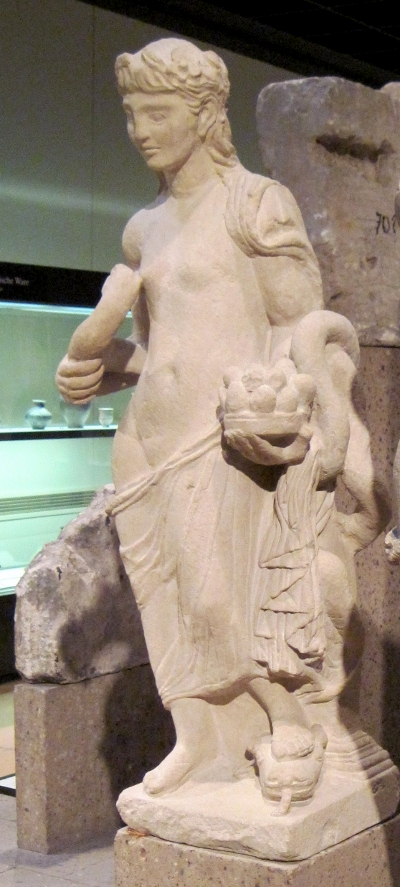
Depiction of a goddess—perhaps the Celtic Ðirona—as Hygieia, a Greek goddess of health. The style strikes me as related to Etruscan or Archaic Greek art.
(Römisch-Germanisches Museum, Köln)
Syncretism and the parallel phenomena outlined above attest diverse ways of acommodating oneself within a pluralistic and polytheist régime. Classical culture was adopted selectively even as it was adapted to the habits and ways of thinking of an originally Celtic (and other) society. Latin may be seen to advance relative to the Gaulish language, but Roman hegemony never entailed the systematic annihilation of all Celtic heritage. On the contrary, cohabitation gave rise to novel cultural fusions.
Certain pagans today see nothing in syncretism but cultural appropriation. Roman colonization, according to this school of thought, connived at the destruction of everything Celtic and therefore appropriated Celtic deities in order to deny their identities. This framework of analysis is problematic to say the least. It denies agency to the conquered peoples, whose role in Gallo-Roman syncretism was crucial. It often erases the distinction between Rome’s heterogenous empire and 18th- and 19th-century European colonization, even though their modalities, aims, and historical contexts were altogether different. Imperial power imposed no cultus upon the conquered provinces, with the fairly nominal exception of vows for the well-being of Rome and the Emperor. It did suppress the druids as an organized college or order, but everyone remained free to worship the gods and goddesses whom the druids had taught about. We know from abundant evidence that Roman citizens in Gaul worshipped local deities, that peregrines worshipped Roman deities, and that both worshipped syncretic deities. To denounce all of this as the simple fruit of coercion would be to impose a grotesque caricature on the observable facts.
Rejection of syncretism implicitly presupposes an ethno-cultural purism in its place. Many polytheists who distance themselves from syncretism prefer a Gaulish religion whose Celtic traits have been ‘decontaminated’ of Roman influence. Yet the latter goes back centuries. In pre-Roman times, prestige goods and objets d’art of Roman, Etruscan, and Greek manufacture are to be found wherever people had the means to acquire them. Worse still, cultural purism and Celtomania have sinister historical connotations it would be best to avoid. Though anti-Romanism often speaks an anti-imperialist language, it takes the form of the erasure of subaltern populations’ religious practices within a polyglot and multicultural Empire. If the non-Roman population of such-and-such a place preferred to worship the god Mercury, do we honour their memory by effacing the very name of Mercury in favour of Lugus or Esus? Is that anti-colonial liberation—or a misappropriation of the image of genuine anti-colonial struggles? Hatred of Rome and Latin culture in the English-speaking world, and Celtomania in the French- and German-speaking worlds, have too often colluded in racist and exclusionary projects to simply declare themselves innocent in these matters without serious reflection.
To the contrary, the diverse cultic accommodations that we see in Roman Gaul seem to offer opportune examples for ourselves who likewise inhabit multicultural societies. If some of the diverse inhabitants of Strasbourg or Montreal feel called upon to explore a syncretism of Gaulish Mercury with Exu, Papa Legba, or Ganesha, they could, to my mind, claim the warrant of ancient practices in doing so.
Syncretistic religious phenomena would furnish the text for philosophical and theological speculation worthy of the schools of Marseille or Autun, where the Platonic, Stoic, and other systems were widely taught. What is a hypostasis? an emanation? a parhedros? Does participating in a divine nature mean losing oneself in it, or being born out of it? Do the deities familiar to us belong to the sublunar sphere or to a more transcendent plane? I do not claim to have the answers to any of these questions, but it would do us good to reflect upon them some fine day.
Acknowledgements
I warmly thank Bruniāχildis U̯oretoχdoniā, Selgu̯iros Carantos Caitacos, Cassanâ Sunicia Sigroni, Runosagiton of the many names, Leton Bebronas, Cunobelinus Betullicnos, Āgiknos Ianau̯anākos, Snaiwagaz Sīrēdija, Drunertos Moudowātis Tarvocnos, RamenFox, Nertatis Cingetos, and the other members and participants in the discussions on syncretism in the Discord servers of Mantalon Bolgon and/or of Forum Gallicum. Their ideas, questions, contributions of resources, feedback, and encouragement were indispensable to the completion of this essay.
Notes

En français svp !

Auf deutsch, bitte!
